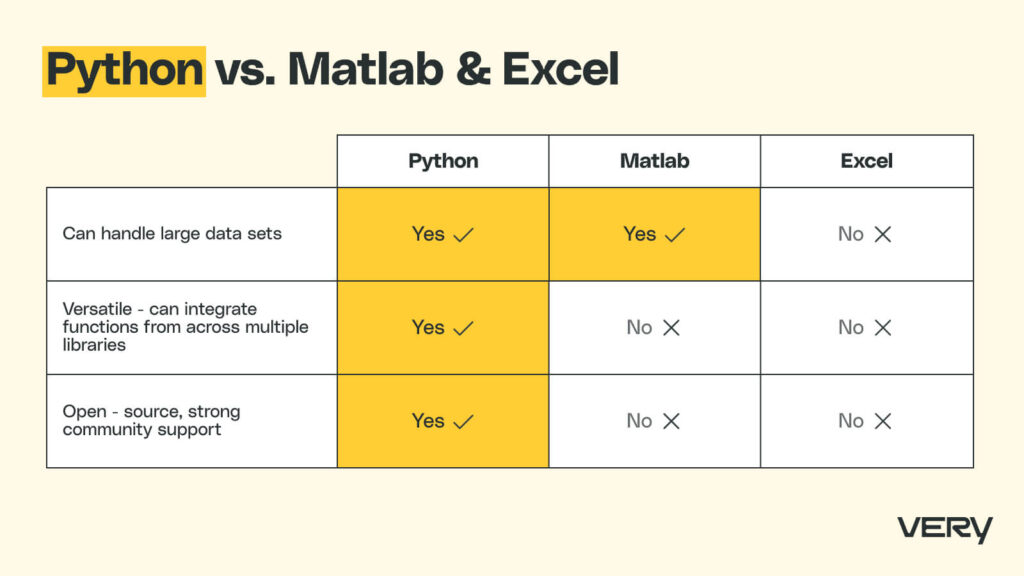BLOG
Why Mechanical Engineers Should Embrace Python Programming
There’s a stereotype that mechanical engineers try to avoid programming as much as possible. If we can’t automate it in Excel, then we avoid it altogether. Programming usually takes a back seat (or no seat at all) to what mechanical engineers focus on during day-to-day work. Most of a mechanical engineer’s mindset is zeroed in on machine design, dynamics, and material science, not programming.
What we often don’t realize, however, is that learning to program can help us to work smarter instead of harder – especially in the world of IoT development. Avoiding programming just because you do not like to program or because you are afraid you could not learn it well enough can actually end up hurting you in the long run.
Luckily, there are programming languages out there that are accessible enough that you can learn the basics pretty quickly. Python is one of them, and for me, it’s become an invaluable tool for various tasks in a mechanical engineering setting.
Why Would a Mechanical Engineer Need/Want to Learn Python?
So, why would a mechanical engineer want to learn to program and, more specifically, learn to program in Python?
In 2019, Python “reached its highest rating ever in the monthly TIOBE index of programming language popularity, ” writes Paul Krill for InfoWorld, and in 2020 and 2021 Python ranked first as the Most Popular Programming Language, a position that continues as of July 2023 and which earned it entry to the TIOBE Index Programming Language Hall of Fame.
Given this explosion in popularity, a growing number of employers are adding Python to their required skill lists. However, that’s only one reason to learn this programming language. Python, in its simplicity, is very learner-friendly; its syntax tries to be as close to plain English as possible, so you can read and write Python code within a few hours. More importantly, mastering Python unlocks a realm of infinite opportunities, broadening your scope in the world of programming.
Python can open doors to a faster and more optimized workflow, simulate a huge amount of data, and most crucially, it can automate boring and tedious tasks so that they’re finished in a matter of seconds.
Let’s dive into some examples.
What Can a Mechanical Engineer Do With Python Programming?

What exactly can you do with Python as a mechanical engineer? One of the most useful things you can do is run numerical analyses.
With the many packages that come with Python, like NumPy and SciPy, you can use built-in functions to run numerical analyses faster and easier than ever before. With SciPy, you can integrate, plot, and even sparse without ever going through the hand calculation. This saves a huge amount of time.
With just a little bit of setup in the beginning, you can use Python to write a program that will execute any calculations you need in an instant.
Thermodynamics Numerical Analysis
Another example of what you can do is a simple finite element analysis. Thermodynamics numerical analysis is a great example; with the PYro tool, we can easily calculate “most common thermodynamic properties from temperature and pressure such as density, enthalpy, entropy, internal energy, molecular weight, specific heats, specific heat ratio, and specific volume.”
Computational Fluid Dynamics
Computational fluid dynamics also lends itself well to Python programming. PyCFD uses the language to write and solve partial differential equations, calculate fluid volumechanical engineers with Navier-Stokes equations, and use the boundary element method for solving boundary value partial differential equations.
Overall, this creates three main benefits for mechanical engineers at their organizations. First, keep in mind that the rest of the company can use your scripts once you’ve written them, just as you can use your colleague’s code. This saves time for everyone and allows you to work more efficiently as a team.
Second, we can boost automation even further by scripting customized features on a platform like Onshape. Essentially, this lets us quickly and easily generate custom features for use in our projects. These include custom beams, airfoil, spur gears, ray tracers, and wiring.
Finally, Python lets us automate large calculations that can otherwise be too unwieldy or time-consuming. The language excels at floating point arithmetic and is capable of handling up to 17 significant digits. It’s no wonder Python forms the basis for mathematically intensive machine learning (ML) frameworks like PyTorch.
Want to discover how Very’s engineers use Python and other programming languages to deliver the next generation of IoT devices? Learn more here.
What Can Python Programming Do for Mechanical Engineers that MATLAB and Excel Can’t?

There is a reason Excel and Google Sheets are used so extensively within businesses. Spreadsheets have a lot of easy-to-use features and it is fairly quick for new users to ramp up big projects in these programs.
However, Excel and others like it have their limitations. Excel suffers when the data gets very large. Python, on the other hand, is the go-to data science tool for big data jobs.
Not only do Python’s high-level features accelerate code development and make solving problems more intuitive, but the scientific community already has a wealth of libraries that are ready to use out of the box.
These include scientific packages like NumPy and SciPy which we mentioned above, but that’s just the tip of the iceberg.
Matplotlib is a 2D graph plotting library that’s ideal for scientific and engineering jobs, while SymPy is designed specifically for symbolic computing tasks that range from calculus to quantum physics.
There’s even Mechpy, a Python toolbox built just for mechanical engineers.

When we compare MATLAB to Python, the difference is also clear. While both are interpreted languages, there are both technical and philosophical differences between them.
Besides details like variations in MATLAB and Python syntax, Python is much more versatile than MATLAB, has a much more vibrant support community, and has most of the same functionality. The exception is MATLAB’s Simulink for simulation and model-based design.
These technical details mostly stem from their divergent approaches to development: MATLAB is proprietary, closed-source software, while Python is an open-source project that’s supported by hundreds of developers.
This ultimately boils down to a few key benefits in Python’s favor. First, Python’s versatility allows us to do more with less. The same program can integrate functions from across multiple libraries, simplifying workflows and requiring less user input. And we all know what happens when a company has way too many spreadsheets. Python programming reduces this complexity by allowing us to combine much of this work into a single, unified platform.
Importance of Python Programming for Mechanical Engineers
Computer programming may not be our main focus as mechanical engineers, but in today’s digital world, these skills are crucial. Learning a user-friendly language like Python can pay huge dividends. Since this language comechanical engineers pre-equipped with all the scientific and mathematical tools we need, it’s easy to expand Python scripting into many use cases as your command over it grows.
There’s a good reason we’ve seen such a meteoric rise in Python’s popularity. It’s one of three official languages at Google. It’s the basis for major services like DropBox and Netflix. Just like these web services, our mechanical designs benefit from Python expertise.
KEEP READING: Find out how Very helped Hayward develop a revolutionary IoT app that delivers an exceptional user experience.











